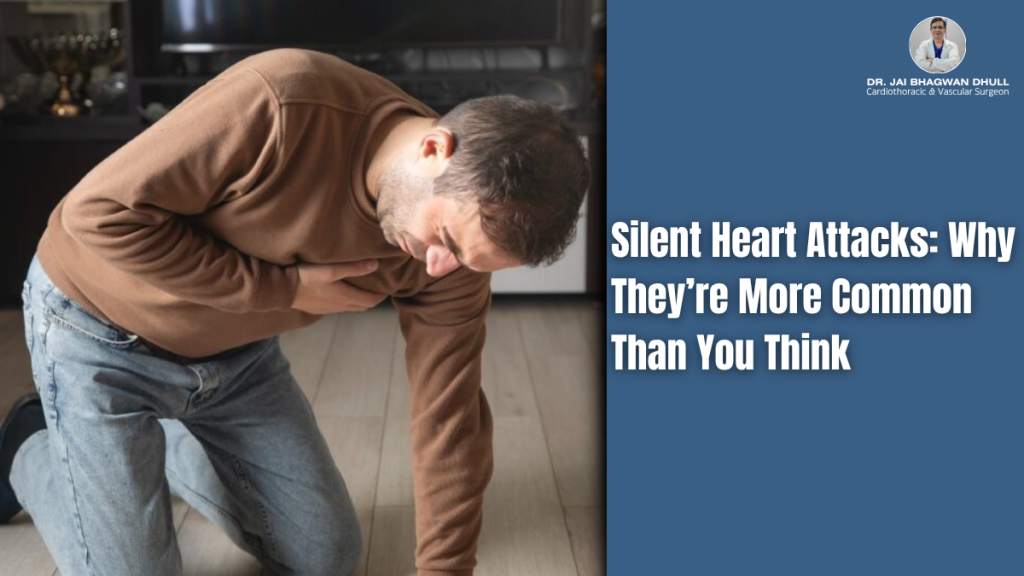When people think of a heart attack, they often picture sudden chest pain, dramatic symptoms, and a rush to the emergency room. But in reality, not all heart attacks look the same. A silent heart attack—also known as a “silent myocardial infarction”—can occur without the typical, textbook warning signs. Many people only realize they’ve had one after a routine check-up, an ECG, or a consultation with a heart specialist. According to leading cardiologists like Dr. Jai Bhagwan Dhull, the silent nature of these heart attacks makes them especially dangerous, as people often fail to seek medical attention until complications arise.
What Exactly Is a Silent Heart Attack?
A silent heart attack happens when blood flow to part of the heart muscle is blocked, just like a typical heart attack. The difference lies in the symptoms—or rather, the lack of them. Instead of crushing chest pain, the signs may be so mild or vague that they’re mistaken for fatigue, indigestion, or even anxiety.
Common subtle signs include:
- Mild discomfort in the chest or upper body
- Shortness of breath
- Lightheadedness or unusual fatigue
- Nausea or indigestion-like symptoms
Since these symptoms can easily be ignored, people often continue with their day-to-day lives, unaware that permanent damage is being done to their heart.
Why Are Silent Heart Attacks More Common Than You Think?
1. Modern Lifestyle Factors
Busy schedules, chronic stress, poor dietary habits, and sedentary routines are contributing to the rising number of silent heart attacks. People often brush off early warning signs, assuming they’re due to work pressure or lack of sleep.
2. Overlap With Other Conditions
As Dr. Jai Bhagwan Dhull points out in his clinical practice, many silent heart attacks are overlooked because their symptoms resemble those of gastric problems, anxiety, or age-related fatigue. This overlap leads to late diagnosis and delayed treatment.
3. Higher Incidence in Certain Groups
Research shows silent heart attacks are more common among women, diabetics, and the elderly. For instance, diabetics often have nerve damage (neuropathy) that dulls pain signals, which makes it harder to feel the chest pain typically associated with heart attacks.
4. Lack of Awareness
Public awareness campaigns often highlight the dramatic symptoms of heart attacks but rarely emphasize the subtle ones. This knowledge gap leaves many people vulnerable.
The Hidden Dangers
The most concerning aspect of silent heart attacks is the long-term damage. Even if the immediate symptoms are mild, the impact on the heart muscle is just as severe as a typical heart attack. Without treatment, this damage can lead to:
- Heart failure
- Arrhythmias (irregular heartbeats)
- Increased risk of future, more severe heart attacks
- Sudden cardiac death
According to Dr. Jai Bhagwan Dhull, patients who discover a past silent heart attack during routine check-ups are often shocked to learn that their heart has already sustained irreversible damage.
How Are Silent Heart Attacks Diagnosed?
Since silent heart attacks don’t usually bring patients to the emergency room, diagnosis often happens by chance. Common methods include:
- Electrocardiogram (ECG): Can show evidence of an old heart attack even if the patient didn’t notice symptoms.
- Echocardiogram: Uses ultrasound to assess heart muscle damage.
- Blood Tests: May detect enzymes released during heart muscle injury.
- Stress Tests or Imaging: Sometimes used when patients have unexplained fatigue, chest discomfort, or risk factors.
Regular cardiac check-ups are especially important for individuals with risk factors like high blood pressure, diabetes, smoking history, or a family history of heart disease.
Prevention: The Best Protection
The good news is that silent heart attacks, like other heart problems, can often be prevented through lifestyle modifications and timely medical intervention.
Lifestyle Tips for Prevention
- Adopt a Heart-Healthy Diet: Reduce intake of processed foods, sugar, and trans fats. Increase vegetables, fruits, lean protein, and whole grains.
- Stay Active: Aim for at least 30 minutes of moderate exercise, five days a week.
- Quit Smoking: Smoking damages arteries and accelerates heart disease.
- Manage Stress: Techniques like meditation, yoga, and mindful breathing can reduce cardiovascular strain.
- Monitor Health Parameters: Regularly check blood pressure, cholesterol, and blood sugar levels.
Role of Specialists
When it comes to prevention and management, consulting an experienced cardiologist is vital. Experts like Dr. Jai Bhagwan Dhull, who has extensive experience in treating cardiovascular conditions, stress the importance of proactive heart screenings—especially for people with risk factors. Early detection not only helps prevent silent heart attacks but also reduces the likelihood of long-term complications.
What To Do If You Suspect a Silent Heart Attack
If you experience unusual fatigue, unexplained breathlessness, or discomfort in the chest or upper body, don’t ignore it. Seek medical advice promptly. Even if symptoms feel minor, it’s better to rule out a heart problem than to risk permanent damage.
Cardiologists like Dr. Jai Bhagwan Dhull recommend routine heart health evaluations, especially for individuals over 40, those with diabetes, or those who have a family history of cardiac problems. Preventive check-ups, combined with a healthy lifestyle, remain the most powerful tools in reducing the risk of silent heart attacks.
Final Thoughts
Silent heart attacks are far more common than most people realize. Their deceptive nature makes them one of the most dangerous forms of heart disease. Unlike traditional heart attacks, they don’t always announce themselves with dramatic pain or collapse. Instead, they creep in quietly, leaving behind significant damage that often goes unnoticed until it’s too late.
Awareness is the first step in prevention. By learning the subtle signs, understanding the risks, and prioritizing regular check-ups, individuals can protect their heart health. And with guidance from specialists such as Dr. Jai Bhagwan Dhull, patients can take a proactive role in preventing heart disease and safeguarding their future.
